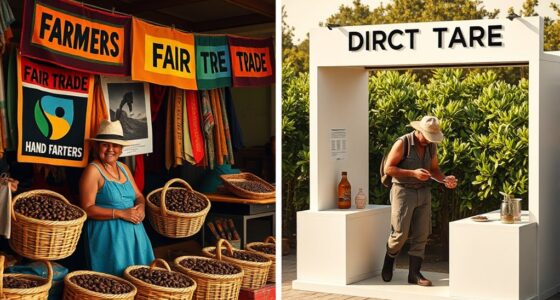Adopting circular packaging in coffee means you can actively help reduce waste by choosing options that are reusable, refillable, or easily recyclable. When you support brands that focus on sustainable designs, you encourage industry-wide shifts toward eco-friendly practices. Using refill stations or bringing your own containers helps minimize single-use waste and keeps packaging materials in circulation. Keep exploring how your choices can make a real difference in creating a more sustainable coffee scene.
Key Takeaways
- Emphasize designing coffee packaging for easy reuse, refill, and recyclability to reduce environmental impact and waste.
- Consumer participation, such as bringing reusable containers and supporting refill stations, drives circular packaging adoption.
- Clear labeling and consumer education are essential for proper recycling and ensuring packaging materials re-enter the circular system.
- Industry innovations focus on recyclable, biodegradable, and reusable materials to promote sustainable packaging solutions.
- Technological advancements improve recycling processes, enabling more efficient recovery and reuse of coffee packaging materials.

Have you ever wondered how the coffee industry can reduce waste and become more sustainable? One effective way is through the adoption of circular packaging practices that focus on reuse, refill, and recyclability. These practices are designed to minimize environmental impact by creating packaging solutions that can be continually cycled back into use. As a consumer, your choices and behavior play a paramount role in supporting this shift. By opting for products that use biodegradable materials, you’re helping to reduce the accumulation of non-biodegradable waste that often ends up in landfills and oceans. Biodegradable packaging breaks down naturally over time, lessening the environmental burden and making it easier for ecosystems to recover. When you choose coffee packaged in biodegradable materials, you’re actively participating in a more sustainable cycle, encouraging companies to prioritize eco-friendly options and invest in innovative packaging solutions.
Your consumer behavior can influence the entire supply chain. When you support brands that prioritize circular packaging, you send a clear message that sustainability matters. This can motivate companies to redesign their packaging to be more reusable or recyclable, creating a ripple effect across the industry. Reusable coffee containers and refill stations are gaining popularity because they align with this mindset. By bringing your own cup or container, you’re reducing single-use waste and helping to normalize reuse practices. Many coffee shops now offer incentives for customers who bring their own cups, further reinforcing the importance of sustainable habits. Refill systems, where you can top up your container at the store, also cut down on packaging waste. These initiatives depend on consumer willingness to embrace reuse, which is key to making circular packaging a standard practice. Additionally, advancements in recycling technology are making it easier to process various packaging materials efficiently and responsibly.
Recyclability is another essential aspect of sustainable coffee packaging. When packaging is designed to be easily recycled, it ensures that materials aren’t discarded as waste but are instead reprocessed into new products. Clear labeling and education about recycling procedures help consumers make informed decisions and properly dispose of packaging. Your participation in recycling efforts ensures that materials like paper, plastic, or metal are kept in circulation, reducing the need for virgin resources. The shift to recyclable packaging isn’t just about individual actions; it also requires manufacturers to design with end-of-life in mind. By supporting brands committed to recyclable packaging, you contribute to a more circular economy, where resources are reused rather than wasted. Ultimately, your choices as a consumer—favoring biodegradable, reusable, and recyclable packaging—drive the industry toward more sustainable, circular practices.
Frequently Asked Questions
How Do Circular Coffee Packages Impact Flavor Preservation?
Circular coffee packages help preserve flavor integrity by reducing exposure to air and light, thanks to improved packaging permeability. When you choose reusable or refillable containers, you minimize oxygen contact, which can degrade coffee’s freshness. Properly designed circular packaging maintains the aroma and flavor longer, ensuring your coffee stays fresh and tasty. So, by using eco-friendly packages, you’re also supporting better flavor preservation for every brew.
Are Refillable Coffee Containers Cost-Effective Long-Term?
Refillable coffee containers can be cost-effective long-term, just like planting a tree that grows bigger and stronger over time. You’ll notice cost savings on frequent purchases and enjoy positive consumer perception as eco-conscious choices matter more. While initial investments might seem high, refilling reduces packaging waste and expenses, making it a smart, sustainable option that pays off as you continue to reuse and benefit from lower costs over the years.
What Materials Are Safest for Recycling Coffee Packaging?
You should choose materials with proven safety for recycling, like PET plastic, aluminum, or glass. These materials have excellent recycling compatibility and are widely accepted in recycling facilities. They’re safe for the environment and uphold material safety standards, reducing contamination risks. Using such materials guarantees your coffee packaging is recyclable, eco-friendly, and aligns with circular economy principles, making your packaging both sustainable and responsible.
How Do Circular Packaging Practices Influence Coffee Shelf Life?
Think of circular packaging practices as a shield for your coffee’s freshness. By prioritizing packaging durability and materials that support shelf life extension, you help preserve aroma and flavor longer. Reusable and refillable containers reduce waste while maintaining quality, ensuring your coffee stays fresh from bean to cup. These practices create a cycle that benefits both the environment and your enjoyment, making every sip even more satisfying.
Can Small Coffee Brands Easily Adopt Circular Packaging Methods?
Small coffee brands can adopt circular packaging methods, but they face brand adoption challenges like limited resources and market awareness. You’ll need to navigate supply chain integration, which can be complex and costly initially. However, with strategic planning and partnerships, you can overcome these obstacles. Embracing circular packaging not only aligns with eco-conscious consumers but also differentiates your brand in a competitive market.
Conclusion
By embracing circular packaging in coffee, you’re not just making a small change—you’re transforming the entire industry. Reusing, refilling, and recycling aren’t just trends; they’re your superpowers to save the planet from an environmental catastrophe of epic proportions. Every sip you take can be a step toward a greener, cleaner future. So, choose circular, and become a hero in the fight against waste—because the future of coffee and Earth depends on it!









